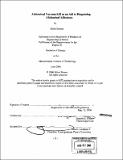| dc.contributor.advisor | Ernesto E. Blanco. | en_US |
| dc.contributor.author | Strauss, Julius (Julius Y.) | en_US |
| dc.contributor.other | Massachusetts Institute of Technology. Dept. of Mechanical Engineering. | en_US |
| dc.date.accessioned | 2007-03-12T17:45:12Z | |
| dc.date.available | 2007-03-12T17:45:12Z | |
| dc.date.copyright | 2006 | en_US |
| dc.date.issued | 2006 | en_US |
| dc.identifier.uri | http://hdl.handle.net/1721.1/36695 | |
| dc.description | Thesis (S.B.)--Massachusetts Institute of Technology, Dept. of Mechanical Engineering, 2006. | en_US |
| dc.description | Includes bibliographical references (leaves 18-22). | en_US |
| dc.description.abstract | The internal organs are designed to move freely and slide over one another during normal body movement. The abdominal organs, however, have a tendency to adhere to the abdominal cavity (peritoneum) and other abdominal organs after surgery or infection. These adhesions can cause pain, discomfort , inflammation, anxiety, depression, problems with conception, trouble eating, and decreased immune function. There are around 300,000 hospital admissions in the U.S. every year for patients due to adhesions.. Part of the problem is that there is no suitable method to diagnose adhesions. Recently there have been a number of studies which suggest that measuring visceral slides under ultrasound using exaggerated respiration may prove to be very promising in diagnosing adhesions non invasively. Yet there are still weaknesses in the predictive power of these procedures. For such procedures to be successfully implemented into clinical medicine and offer non invasive methods to diagnosing adhesions, they must first be able to offer higher percentage predictive values. We have worked on a number of models of an external abdominal vacuum system which we believe will increase the accuracy and predictive values of measuring visceral slides under ultrasound using exaggerated respiration. | en_US |
| dc.description.statementofresponsibility | by Julius Strauss. | en_US |
| dc.format.extent | 27 leaves | en_US |
| dc.language.iso | eng | en_US |
| dc.publisher | Massachusetts Institute of Technology | en_US |
| dc.rights | M.I.T. theses are protected by copyright. They may be viewed from this source for any purpose, but reproduction or distribution in any format is prohibited without written permission. See provided URL for inquiries about permission. | en_US |
| dc.rights.uri | http://dspace.mit.edu/handle/1721.1/7582 | |
| dc.subject | Mechanical Engineering. | en_US |
| dc.title | Abdominal vacuum lift as an aid to diagnosing abdominal adhesions | en_US |
| dc.type | Thesis | en_US |
| dc.description.degree | S.B. | en_US |
| dc.contributor.department | Massachusetts Institute of Technology. Department of Mechanical Engineering | |
| dc.identifier.oclc | 77538620 | en_US |

